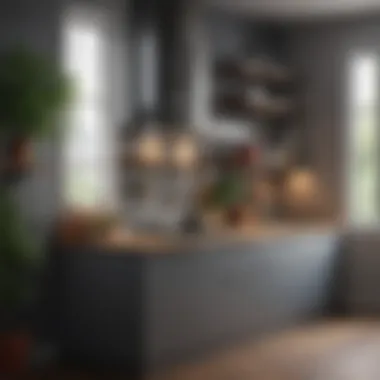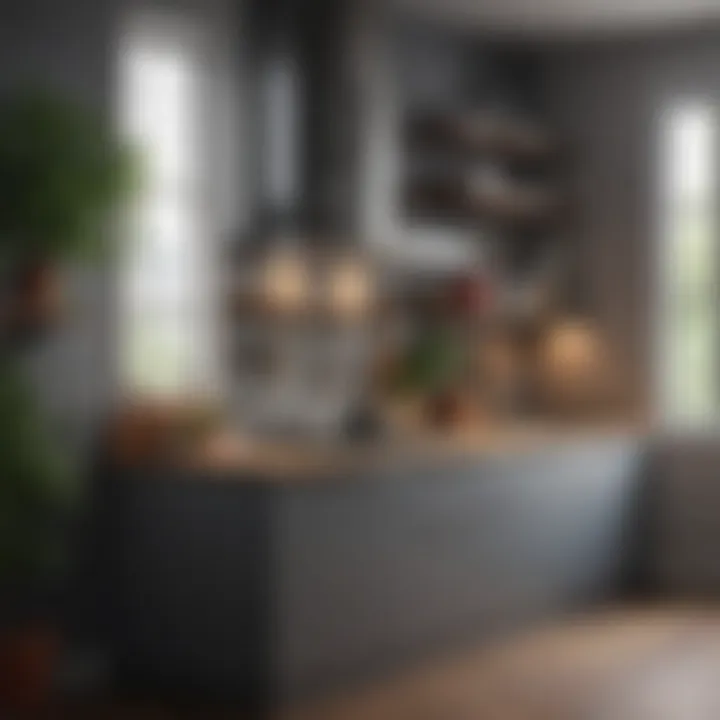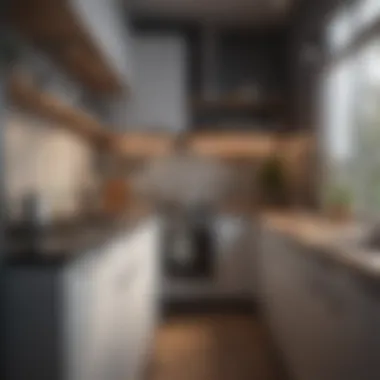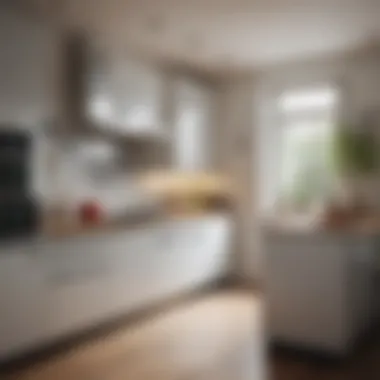Creative Miniature Kitchen Designs for Small Spaces


Intro
In urban settings, where space is often at a premium, rethinking kitchen design becomes not just a choice, but a necessity. Small kitchens can be both stylish and functional if approached with creativity and thoughtful planning. Homeowners and interior design enthusiasts alike are often faced with the challenge of making the most out of their compact environments. By embracing innovative ideas and practical solutions, anyone can transform their limited kitchen space into a hub of efficiency and aesthetic appeal.
As we journey through this article, we will delve into design inspirations that breathe life into miniature kitchens, and provide practical tips that promise longevity and ease of use. Get ready to explore how the right colors, styles, and storage solutions can revitalize one of the most central spaces in your home.
Design Inspiration
Trending Styles
When it comes to compact kitchens, integrating trending styles not only reflects modern tastes but also maximizes functionality. One prevalent trend is the minimalistic approach, which emphasizes clean lines and open spaces. This style often employs integrated appliances and hidden storage, creating an illusion of more space.
Another style gaining traction is the Scandinavian aesthetic. This design philosophy celebrates simplicity through functional decor and light colors. Materials like natural wood and stone can impart warmth, while white or pastel accents enhance brightness, making the kitchen feel airy.
"A well-designed kitchen is a balance of aesthetics and practicality that caters to everyday living."
Color Palettes
The choice of colors directly impacts the spatial perception of your kitchen. Light shades, such as soft whites, beiges, and pale blues, can create an illusion of spaciousness. Conversely, deeper hues can add character but should be paired carefully with adequate lighting.
Using pops of color as accents is also a clever way to liven up your space. For example:
- Bright backsplash tiles can provide a focal point without overwhelming the area.
- Colorful accessories like cabinets or kitchenware can enhance the vibrancy without the need for extensive renovations.
Practical Tips
Maintenance & Care
In a small kitchen, proper maintenance becomes critical. The surface materials should be easy to clean and durable. Opt for countertops made of quartz or granite, as they can withstand heavy usage while maintaining their elegance. Also, consider incorporating tools that simplify upkeep, like self-cleaning ovens or integrated dishwashers that optimize your workflow.
Regular cleaning not only prolongs the life of your kitchen but also enhances its overall charm.
Budgeting & Planning
Budgeting for a miniature kitchen doesn’t have to break the bank. Start with a clear plan that prioritizes your needs. Consider features that you use most frequently and allocate funds accordingly.
When estimating costs:
- Research bulk purchasing for materials like cabinets.
- Explore DIY options for smaller installations, as they can save labor costs.
- Follow sales or seasonal offers for high-ticket items.
Being savvy about your choices today can yield significant savings down the road. Keep an eye on trends through resources like Britannica or forums on Reddit where fellow homeowners often share their experiences and tips.
With the right blend of style and practicality, your small kitchen can become a delightful space that not only looks good but feels good to work in. The next sections will continue to unravel more ingenious ideas tailored for those navigating the world of miniature kitchens.
Preamble to Miniature Kitchens
When it comes to modern living, especially in urban environments, the need for efficient use of space cannot be overstated. Miniature kitchens, often confined within tight quarters, pose unique challenges and opportunities. They are not just about squeezing in essential appliances; they embody a savvy approach to lifestyle, emphasizing practicality while maintaining aesthetic appeal.
In this article, we dive into the world of miniature kitchens, exploring creative solutions that blend functionality and design. With space at an ever-increasing premium, understanding how to optimize a small kitchen is vital for homeowners, interior design enthusiasts, and anyone who entertains guests in compact settings.
Defining Miniature Kitchens
This term typically refers to kitchens that occupy less than 100 square feet. Their layouts can vary from galley styles to L-shaped designs, but they all share a common goal: making the most of limited space. In the simplest terms, a miniature kitchen must integrate essential features – cooking zones, storage, and dining areas – into a confined area without compromising comfort or usability.
Here are some characteristics of miniature kitchens:
- Functional Layout: Every inch is precious. A well-thought-out plan is crucial to ensure that each area serves its purpose.
- Compact Appliances: Smaller versions of standard kitchen appliances are often employed to maximize utility without taking up excessive space.
- Clever Storage Solutions: From using vertical space to under-sink storage, creative solutions are essential for keeping a tidy space.
With the growing trend toward smaller living environments, defining a miniature kitchen goes beyond mere size; it speaks to a lifestyle that values efficiency, creativity, and innovation in design.
Trends Influencing Miniature Kitchen Design
The design of miniature kitchens has evolved considerably over the years, influenced by various factors including lifestyle choices, sustainability, and technology. Here's a look at some pivotal trends shaping these compact culinary spaces:
- Sustainability: Homeowners increasingly favor eco-friendly materials and energy-efficient appliances, reflecting a broader societal trend toward sustainability. This often involves using recycled materials and opting for low-energy devices.
- Minimalism: The less-is-more philosophy is gaining traction. Clean lines, uncluttered spaces, and multifunctional furniture dominate modern miniature kitchens, fostering a tranquil environment amid busy lives.
- Smart Technology: The integration of smart appliances that can be controlled via apps or voice commands is on the rise. This not only adds convenience but also enhances space utilization through specialized functionalities.
"Recognizing trends is crucial; they shape how we approach and interact with our living spaces."
As we delve deeper into each section of this article, you’ll discover practical ideas and strategies for transforming small kitchen areas into dynamic and inviting spaces, reflecting both individual style and contemporary design principles.
Understanding Space Utilization


When dealing with miniature kitchens, the phrase "every square inch counts" isn’t just a witty saying; it’s a fundamental truth. Knowing how to optimize space is crucial because it directly influences the kitchen's functionality and, ultimately, its utility. By understanding space utilization, homeowners can transform what could be a cramped, chaotic zone into a practical and inviting cooking area. This section delves into the significance of space evaluation and planning in miniature kitchens.
Assessing Available Space
The first step in any kitchen design is to assess available space. This means taking stock of all the nooks and crannies that one could potentially employ. Don't just measure the walls; look up, look down. How high are the ceilings? Are there alcoves? Is the flooring conducive for proper installations? Even those under-utilized areas—like the space behind a fridge or above cabinets—can serve a purpose if one puts on their thinking cap.
To do this effectively:
- Take Precise Measurements: Having accurate dimensions is fundamental. It ensures that everything from cabinetry to appliances fits like a glove.
- Create a Blueprint: Sketch out how to layout the kitchen. Use tools like graph paper or apps to visualize potential designs.
- Assess Flow: Consider how one moves through the space. Is the kitchen designed for efficiency, or could one trip over a misplaced chair?
"Understanding the available space is like reading a map; only then can you navigate it effectively."
This initial assessment not only helps in visualizing the kitchen but also in identifying what stays and what goes. It sets the stage for other decisions.
Prioritizing Essential Elements
Next up is prioritizing essential elements. In miniature kitchens, it’s not just about stuffing in as many appliances or utensils as possible; it’s about thoughtful selection.
When curating what stays in your kitchen:
- Identify What You Use Most: Keep in mind those items you can’t live without—be it a sauté pan, blender, or a beloved set of knives. Are these essentials taking too much space? Consider compact, stackable options.
- Consider Multi-purpose Items: A toaster oven can replace a microwave and toaster. The more functions a single thing serves, the better. Seek furniture and appliances that serve multiple roles, like a butcher's block that also stores knives.
- Declutter Regularly: It might not be the most thrilling task, but periodic decluttering ensures that your kitchen retains its charm and usability. If you haven’t used an item in the last six months, ask yourself if it’s worth keeping.
In the grand scheme of things, maximizing functionality without compromising style can indeed be a tall order. Yet, by honing in on just those essentials, miniature kitchen owners can create spaces that are not just serviceable, but also inviting and efficent.
By thoughtfully assessing the available space and prioritizing essential elements, we've laid the groundwork for any miniature kitchen’s design process. Such meticulous planning significantly enhances the functionality and overall appeal of these compact cooking spaces.
Modular Kitchen Solutions
In a world where space is often at a premium, modular kitchen solutions have emerged as a key player in the game of optimization. These adaptable spaces not only serve their primary function but do so with immense flair and style. Implementing modular designs in miniature kitchens can significantly transform how these environments are utilized. The importance of modular kitchen solutions lies in their ability to maximize every inch of available space while providing practicality and visual appeal.
One standout advantage of modular kitchens is their versatility. You can rearrange, add, or remove components depending on your cooking habits, lifestyle changes, or family needs. They allow apartment dwellers to personalize their spaces, melding functionality with aesthetics. No more feeling cramped or boxed in; you create a flow that works for you. With modular solutions, individual units can be tailored to accommodate both large family dinners and solo meal prep through clever design.
Another notable benefit is the efficiency of storage. With elements designed to fit seamlessly into smaller spaces, you’ll find clever nooks and crannies that can store everything from pots and pans to small kitchen gadgets. For instance, consider cabinets with pull-out shelves that make the most of deep spaces or a kitchen island that evolves into a dining table when entertaining guests.
However, when delving into modular kitchen solutions, various considerations should be kept in mind. The materials used, the style of the components, and how they harmonize with the overall décor are crucial. Choose durable materials capable of withstanding daily use; options like laminated surfaces are often both aesthetically pleasing and resilient. The right colors can create an illusion of larger spaces. Light shades, especially, can reflect more light, making your tiny kitchen feel airy and open.
"Modular kitchen solutions represent not just practicality but a philosophy of living that embraces adaptability."
Overall, the design of a modular kitchen is about balance. With a solid plan and eye for detail, one can inject a uniquely personal touch that transforms not only the kitchen's capabilities but its ambiance. Let’s dive into specific elements of modular kitchens that stand out profoundly.
Transformable Furniture
Transformable furniture is a game changer when it comes to making the most out of limited kitchen space. Imagine a kitchen table that can shift from a compact setting for breakfast to an expansive area for a dinner party. These pieces often fold, extend, or even morph, helping you adapt your setup based on the moment’s need.
Careful choices in design form the basis of functional furniture, providing homeowners with many dynamic possibilities. Look for solutions that can integrate seamlessly with other kitchen units. A bench or seating that doubles as storage can make all the difference, ensuring that every piece of furniture serves multiple functions.
Multi-functional Appliances
In the modern culinary world, multi-functional appliances are not just practical; they’re essential. A gadget that combines the roles of a rice cooker, steamer, and slow cooker can save valuable space while providing a range of cooking methods at the touch of a button. Think about devices like the Instant Pot or a combination microwave and convection oven. They enable creative cooking without requiring excess counter space or specialized cooking tools.
The key to selecting these appliances is versatility and efficiency. Look for options that come packed with features yet are easy to operate and clean. Invest in machines that utilize smart technology, offering ease of monitoring and adjustment via apps. When every inch counts, multi-functional appliances elevate the kitchen experience, merging convenience with the art of cooking.
Storage Innovations
Storage innovations play a pivotal role in maximizing the functionality of miniature kitchens. In small spaces, every square inch counts. The ability to store kitchen essentials efficiently not only reflects good design but also enhances the overall cooking experience. As urban living continues to rise, developing clever storage solutions becomes crucial to accommodate various lifestyle needs.
Effective storage helps keep the kitchen organized, making it easier to access utensils, cookware, and ingredients when they’re needed. It can also introduce a sense of order to a compact area that might otherwise feel cluttered. This leads to less stress during meal prep and cooking, ultimately fostering a more enjoyable environment.
When considering storage innovations, it’s essential to think creatively. The right strategies can transform a constrained kitchen into a well-organized haven. Here are some focus areas that showcase the potential of storage innovations in a miniature kitchen:
- Smart design utilizes elements like pull-out shelves, floating cabinets, and modular units to accommodate different items effectively.
- Accessibility ensures that stored items are within reach, allowing for smooth cooking processes.
- Dual-purpose furniture takes advantage of overlapping functions, such as benches with hidden compartments.
"A well-optimized kitchen reflects not just style, but also functionality. In a miniature space, this balance is vital."
By addressing the various facets of storage design, one crafts a kitchen that is not just adequate but excels in both efficiency and visual appeal.
Vertical Storage Concepts
Vertical storage is often a game changer in tight kitchen setups. When floor space is limited, building upward is an effective solution. Utilizing tall shelving units or hanging storage racks can drastically open up space, providing ample room for pots, pans, and spices.
For example, open shelving allows homeowners to display dishware as part of the decor while also keeping essential items easily accessible. The use of pegboards can also be innovative, as they enable flexible organization for utensils and cookware without consuming counter space. Creating vertical gardens for herbs can further streamline both cooking and storage.
Under-sink Solutions


The area beneath the kitchen sink commonly becomes a dumping ground for cleaning supplies and various odds and ends. Yet, it holds potential for innovative storage.
Incorporating tiered trays or stackable bins allows for better organization. Pull-out bins can help outsmart that hard-to-reach corner, making it less of a hassle to fetch cleaning supplies. Implementing doors that conceal clutter can also contribute to a neater aesthetic.
Utilizing Wall Space
Wall space presents a often-overlooked opportunity for kitchen storage optimization. Instead of solely thinking horizontally, consider how areas like walls and backsplashes can be creatively utilized.
Magnetic strips for knives or spices can free up significant counter space. Hooks can be installed to suspend pots or hang utensils, much like a café. Even a simple wall-mounted rack for baking sheets can keep essentials in sight while ensuring they don’t clutter surfaces. Every wall can become a functional part of the kitchen's ecosystem.
In summary, storage innovations in miniature kitchens allow for creative solutions that enhance utility while making the best use of limited space. These strategies provide not only a practical approach to everyday cooking but also personalize the cooking experience.
Color Schemes and Materials
When it comes to miniature kitchens, color schemes and materials play vital roles in not just aesthetics, but functional utilization of space too. The right colors can make a room feel larger or more inviting, while durable materials ensure longevity and perform well under daily wear and tear. Understanding how to harmoniously balance these elements simplifies the design process and enhances the kitchen experience.
Choosing Light Colors for Small Spaces
Opting for light colors in small kitchens can be a game changer. Colors such as soft whites, pale blues, or light grays reflect natural light, creating an illusion of openness. These hues can visually expand the space and promote a more airy environment, which is essential in tighter quarters.
- Psychological Impact: Light colors can stimulate a sense of calm and relaxation. For homeowners, feeling comfortable in a small space can make cooking and entertaining more enjoyable.
- Mixing Shades: Shades of white paired with pastel accents use depth effectively, bringing warmth without sacrificing roominess. For example, white cabinets with a mint green backsplash can pop beautifully while remaining light and cheerful.
- Ceiling Color: Consider painting ceilings in a slightly lighter tone to lift the visual height of the kitchen. This trick often creates the illusion of taller walls, further enhancing the overall feel of spaciousness.
In summary, using light colors judiciously is not just an aesthetic choice; it’s a strategic method for maximizing spatial perception.
Durable Materials for High-use Areas
High-use areas, such as kitchens, require robust materials that can withstand the rigors of everyday life. The choices made here are crucial for both functionality and design longevity.
- Countertops: Materials like quartz or granite resist scratches and stains, providing a reliable work surface. Such durability undoubtedly offsets the initial investment, leading to long-lasting beauty.
- Flooring: Opting for ceramic tiles or luxury vinyl can offer visual appeal while being resilient against foot traffic and spills. These materials are not only easy to clean but also come in a variety of styles and colors to complement the overall design.
- Cabinet Finishes: Seek finishes that resist chipping and fading, such as laminate or solid wood protected with durable stains. These cater to both visual and functional needs, ensuring that the cabinetry looks great while holding up against daily challenges.
By considering durable materials and proper placement, homeowners can ensure that their miniature kitchens remain both beautiful and functional over time.
Remember, a stunning kitchen doesn’t solely depend on looks, but on practical choices that support your lifestyle.
Lighting Strategies
Effective lighting can completely transform a miniature kitchen, making it not just functional but quite inviting. In small spaces, it’s essential to create an illusion of more room while maintaining practical visibility for cooking and cleaning. Depending on how you approach your lighting strategy, you can significantly boost both the ambiance and usability of your kitchen area. Here’s how to tackle this important aspect of miniature kitchen design.
Maximizing Natural Light
Harnessing natural light can work wonders in a compact kitchen. Large windows or strategically placed mirrors can help brighten the room while fostering an airy feeling.
- Windows: Opt for sheer curtains that let in sunlight without sacrificing privacy. This way, you can enjoy the view outside while brightening your space. If you're lucky enough to have a window over your sink, this is an ideal spot to utilize natural light.
- Reflective Surfaces: Mirrors are not just for checking your hairstyle; they also reflect light beautifully. Position a mirror opposite the window to amplify the natural light streaming in. Additionally, glossy tiles or painted cabinets can bounce light around, reducing shadows.
- Open Layouts: If your floor plan allows, think about creating an open layout that connects your kitchen to other areas, such as the living or dining room. This connection enhances natural light distribution, making everything feel more spacious.
"A kitchen filled with light can brighten not just the space, but also your spirits."
Integrating these elements allows for maximum light exposure, which can make even the smallest of kitchens feel larger and more welcoming.
Layered Lighting Techniques
Layered lighting combines different types of lights for a balanced effect, especially crucial in a miniature kitchen. The idea is to use ambient (general), task (specific), and accent (decorative) lighting to create depth and functionality.
- Ambient Lighting: This is your primary source of light, the one that fills the room. Ceiling fixtures or recessed lights are your best bets. Consider dimmable options for versatility during different times of day.
- Task Lighting: To avoid any mishaps with knife skills or hot pots, incorporate task lighting where you most need it. Under-cabinet lights are a favorite among homeowners. They illuminate counters with precision and keep your prep area brightly lit.
- Accent Lighting: Showcase your favorite cookbooks or cookery art with accent lighting. Think of LED strips or small spotlights on shelves. It adds character without overwhelming the overall illumination.
- Smart Lighting: Applying smart technology gives you control over brightness levels and light color. By setting different moods, you can easily transition your kitchen from a bright workspace to a cozy dinner setting.
By using layered lighting wisely, you can not only optimize the physical space but also create an inviting atmosphere that’s perfect for cooking and hosting.
Incorporating Technology
In today’s fast-paced world, technology plays a critical role in our lives, and the kitchen is no exception. Integrating tech into miniature kitchen designs brings numerous advantages, particularly in maximizing space efficiency. It’s not just about convenience; it’s about creating an environment that works for you, especially when every square inch counts. Smart technology can simplify cooking processes, enhance food preservation, and ensure optimal use of space.
When talking about incorporating technology, homeowners should consider not only how the gadgets function but also how they harmonize with the kitchen's existing layout and aesthetics. A strategically placed smart device can transform cluttered areas into streamlined, multifunctional zones. This means you're not merely adding gadgets; you're crafting a holistic cooking space that embodies both style and substance.
Smart Appliances for Efficiency
Smart appliances are paving the way for modern kitchen experiences. These are not your ordinary kitchen gadgets; they are practically mini-computers designed to assist you in cooking, monitoring food quality, and even managing energy consumption. Some of the standout innovations include:
- Smart Fridges: Equipped with touch screens, cameras on the inside, and app connectivity, these refrigerators allow you to keep track of groceries without opening the door. Imagine planning meals in advance just by checking an app, reducing food waste, and saving money on groceries.
- Connected Ovens: Ovens that can be controlled via smartphone apps mean you can preheat your dinner, check on cooking times, or set timers all while lounging in the living room. This seamless distance management proves beneficial in tight quarters where multitasking is a necessity.
- Induction Cooktops: These sleek, flat surfaces heat quickly and evenly, offering exceptional versatility. They’re also easy to clean, making them an ideal choice for smaller kitchens where every bit of maintenance time counts.
In essence, these smart appliances embody efficiency. They help cut down on prep time while improving food quality. It’s no secret that kitchen efficiency equates to enhanced culinary experiences, and investing in smart technology can turn a tiny kitchen into a haven for gastronomic creativity.
Apps for Kitchen Management
In addition to appliances, technology extends its reach through myriad apps designed for kitchen management. These applications can help streamline your cooking and kitchen organization process. Here are some ways these tools can contribute to a miniature kitchen life:


- Meal Planning Apps: Applications like Paprika or Mealime allow users to plan meals based on dietary preferences and pantry inventory. This can significantly reduce unnecessary grocery shopping, thereby saving both space and money.
- Inventory Tracking: Apps that help you keep tabs on your pantry’s contents, like PantryCheck, ensure you know exactly what you have on hand, preventing purchase duplication and maximizing every bit of storage.
- Recipe Apps: Many recipe apps cater specifically to small kitchens, suggesting dishes based on limited ingredients and tools. Some even offer step-by-step video guides to make the cooking process more approachable.
Ultimately, these apps serve as digital assistants for kitchen management. They lend an organized approach to meal preparation and planning, essential in a setting where space is tight and time often feels fleeting.
"By embracing technology in the kitchen, you are not just upgrading appliances; you are embracing a lifestyle change that makes cooking both a pleasure and a practical endeavor."
Through thoughtful integration of technology, miniature kitchens can transform into efficient, stylish spaces that cater to today’s culinary demands.
Personalizing Your Miniature Kitchen
In the domain of miniature kitchens, personalizing your space transcends mere aesthetics; it's about crafting an environment that resonates with your identity and lifestyle. Whether you're an urban dweller in a chic apartment or a family residing in a cozy house, tailoring your kitchen can enhance both functionality and enjoyment. A personalized kitchen speaks volumes about the owner's values, tastes, and preferences, making it imperative to invest time and thought into its design.
Showcasing Individual Style
When it comes to style, the miniature kitchen is a blank canvas waiting to tell your story. You have several avenues to express your individuality, from color choices to materials and layout. Opting for bright placemats, uniquely shaped kitchen tools, or quirky coffee mugs adds character to the space. Even the layout can reflect your lifestyle; perhaps you favor a more open design or a galley style that is efficient for cooking.
- Color Palettes: A fresh coat of paint on cabinets or walls can alter the perception of space. Soft pastels can create a serene environment, while bold colors might energize the room.
- Personal Cookware: Showcase your collection of pots and pans, especially those with unique designs. Not only are they practical, but they can serve as decor, too.
- Artistic Wall Displays: Sticking a few framed photos or art pieces can add a personal touch, making your kitchen feel like an extension of you.
Adding Decorative Elements
Every miniature kitchen can benefit from eye-catching decor that also serves a purpose. Decorative elements can uplift a compact space without crowding it, and often, less is more. Consider these ideas to enhance the charm of your kitchen:
- Herb Gardens: An indoor herb garden, perhaps on the windowsill, is both functional and aesthetically pleasing. You’ll have fresh herbs at your fingertips, plus they serve as natural decor.
- Open Shelves: Using open shelving allows for display space while keeping items accessible. Layer a few decorative jars with spices or display handmade ceramics – it merges functionality with ornamentation.
- Textiles and Linens: Vibrant dish towels, unique aprons, or even a quirky tablecloth can inject personality into a kitchen. Consider seasonal themes or designs that evoke nostalgia.
To summarize, personalizing your miniature kitchen not only makes it functional but also serves as an intimate reflection of who you are. The key lies in harmonizing practicality with personal touches that resonate with your identity while optimizing the space.
"The kitchen is the heart of the home; it's where memories are made and stories are shared."
By incorporating elements that mirror your individuality, you create a space that is truly yours, all while maximizing the efficiency of a limited footprint.
Case Studies of Successful Miniature Kitchens
Examining case studies of successful miniature kitchens provides an insightful roadmap for anyone looking to optimize their own small cooking spaces. These real-life examples illustrate the practical application of design principles and innovative solutions, shedding light on how homeowners translate constraint into creativity. By reviewing diverse approaches from urban apartments to tiny homes, we can uncover various elements that contribute to an efficient kitchen layout. The benefits of studying these cases range from inspiration for unique decor styles to practical strategies that enhance functionality. Moreover, considerations such as budget, lifestyle, and individual needs come into play, making these case studies invaluable resources.
Urban Apartment Inspirations
Urban living often means sacrificing space without sacrificing style. A stunning miniature kitchen within an urban apartment can balance aesthetic appeal with functionality, proving that size doesn’t necessarily dictate grandeur. Take, for example, a chic studio in Tokyo that employs a sliding door system to create flexible kitchen boundaries. When the doors are closed, the kitchen melds seamlessly into the living area, but once opened, it reveals a highly efficient workspace. The cabinetry is crafted to the ceiling, maximizing vertical space and providing ample storage for essential kitchenware.
Another example can be found in a New York City apartment where a bold color palette not only energizes the environment but also creates an illusion of a bigger space. Light blue cabinets, paired with white countertops, combined with well-placed mirrors, help reflect light around the room, making it feel open and airy. The use of fold-out surfaces as dining tables or workspace cutting areas demonstrates how urban dwellers adapt to limited real estate while maintaining a sleek and stylish decor.
In urban settings, keeping clutter at bay is crucial. Thus, incorporating hidden storage solutions can be a game changer. Drawers that extend beneath the counter tops or pull-out pantry racks maximize the available space, allowing for easy access to ingredients while maintaining a clean appearance.
Tiny Home Kitchens
Tiny homes have revolutionized the concept of compact living, and their kitchens are often the heart of the innovation. A notable case is a tiny house in Oregon that showcases how minimal design can lead to maximum efficiency. The kitchen features a compact yet powerful induction cooktop, complemented by space-saving appliances like a combination microwave and oven. Vertical shelves ascend to the ceiling, providing room for spices, pots, and utensils – anything but an afterthought in this thoughtfully designed area.
The charm of tiny home kitchens lies in their ability to combine form and function without overwhelming the senses. Color choices such as soft yellow tones, evoke warmth, making the area feel inviting. Furthermore, the use of reclaimed wood for open shelving speaks to sustainability, while displaying decorative dishware adds a touch of personality.
In these spaces, even the smallest details matter. Underneath the stairs, for instance, may house a wine rack, while a flip-up countertop can serve as a bar during gatherings. Tiny homes teach us not just about optimizing space, but also about smart choices that add character to a living environment.
"Space optimization doesn't just apply to the kitchen; it extends into the heart of the home, impacting how we live and interact."
By understanding these real-world examples, homeowners, interior design enthusiasts, and those simply looking to prepare for their next gathering can gather insights that inspire and inform their kitchen transformations.
The End and Future Trends
The world of miniature kitchens is constantly evolving, reflectingsu the shifting needs of urban dwellers and those who cherish a functional yet stylish living space. In the fast-paced realm we find ourselves in, understanding the importance of concluding this article is key, as it emphasizes both the potential of these designs and future pathways for innovation.
Future Trends are more than just fads; they signify how our lifestyles, preferences, and available technologies can converge to create a dining environment that meets diverse demands. As space becomes more precious —especially in urban settings— new ideas will directly influence the way we design our kitchens. For instance, the rise of smart technology integration allows individuals to optimize every square inch, giving them flexibility and convenience. Digital kitchens equipped with advanced sensors can suggest recipes based on available ingredients, or even order groceries automatically.
The future of kitchen design is not merely about aesthetics; it’s about functionality and adaptability in a confined space.
Evolving Ideas in Miniature Kitchen Design
As we consider how miniature kitchen designs have evolved, it’s evident that they are no longer just about cramming items into a small place. Instead, modern designs emphasize the careful curation of space elements to create a narrative that embodies lifestyle and comfort. Multi-functional appliances are becoming a staple, like ovens that also air fry or dishwashers that blend seamlessly into cabinetry. Furthermore, modular kitchen systems that allow for easy reconfiguration cater to various activities — whether hosting a party or enjoying a quiet dinner at home.
There is also a growing trend toward sustainable materials and eco-friendly design. Bamboo countertops or recycled metal shelving are just some of the options on the rise, reflecting a shift in consumer values towards environmental responsibility. As sustainability continues to reshape design trends, expect more kitchen innovations that focus on minimal environmental impact while maximizing utility.
Final Thoughts on Space Optimization
In closing, the quest for space optimization in miniature kitchens is not just a necessity but an art form. With clever spatial arrangements and innovative designs, even the tiniest kitchens can become culinary havens. Conducting a thorough assessment of available space and prioritizing what matters most allows homeowners to create kitchens that are both functional and aesthetically pleasing.
Key implications of effective space optimization include:
- Enhanced efficiency in daily tasks
- Increased enjoyment and comfort in food preparation
- The personalization that resonates with individual lifestyles
As lifestyles change, so must kitchen designs adapt to fit the needs of those who inhabit them. Embracing this journey toward optimization not only leads to practical solutions but fosters a deeper appreciation for quality over quantity in living spaces. Every small kitchen holds the potential to tell its story; one strength, one choice at a time.
In the end, the ideas discussed here provide a foundation for homeowners, interior design enthusiasts, and anyone involved in the kitchen space to innovate and personalize their environments. The future shines bright for miniature kitchens, and it’s up to us to embrace their possibilities.















